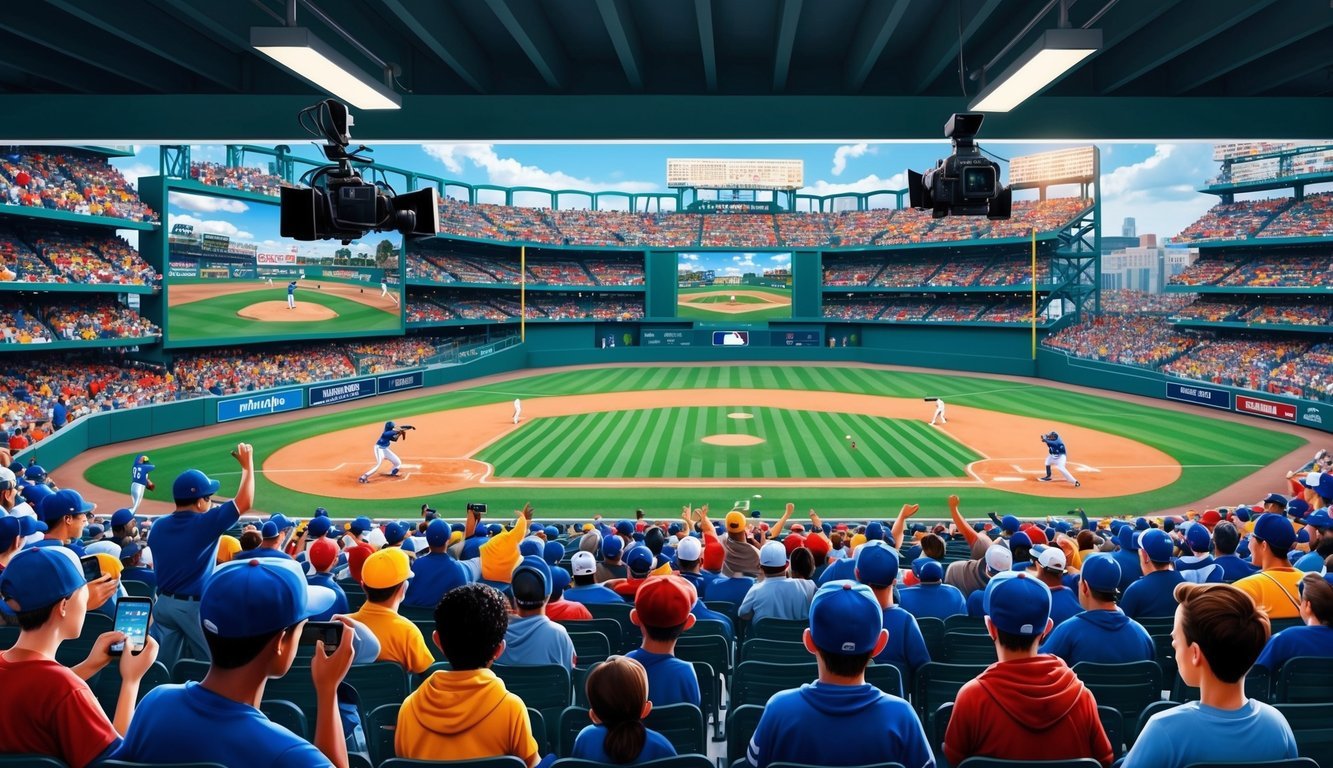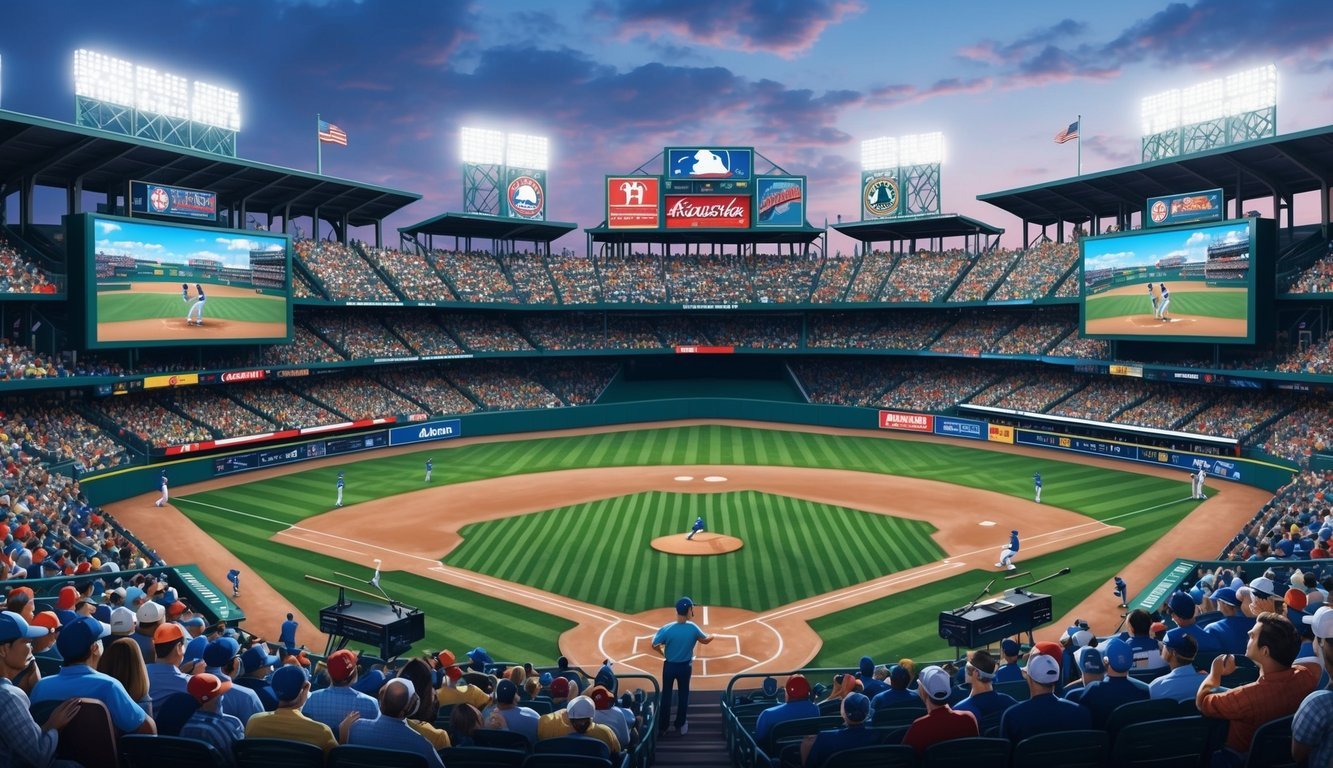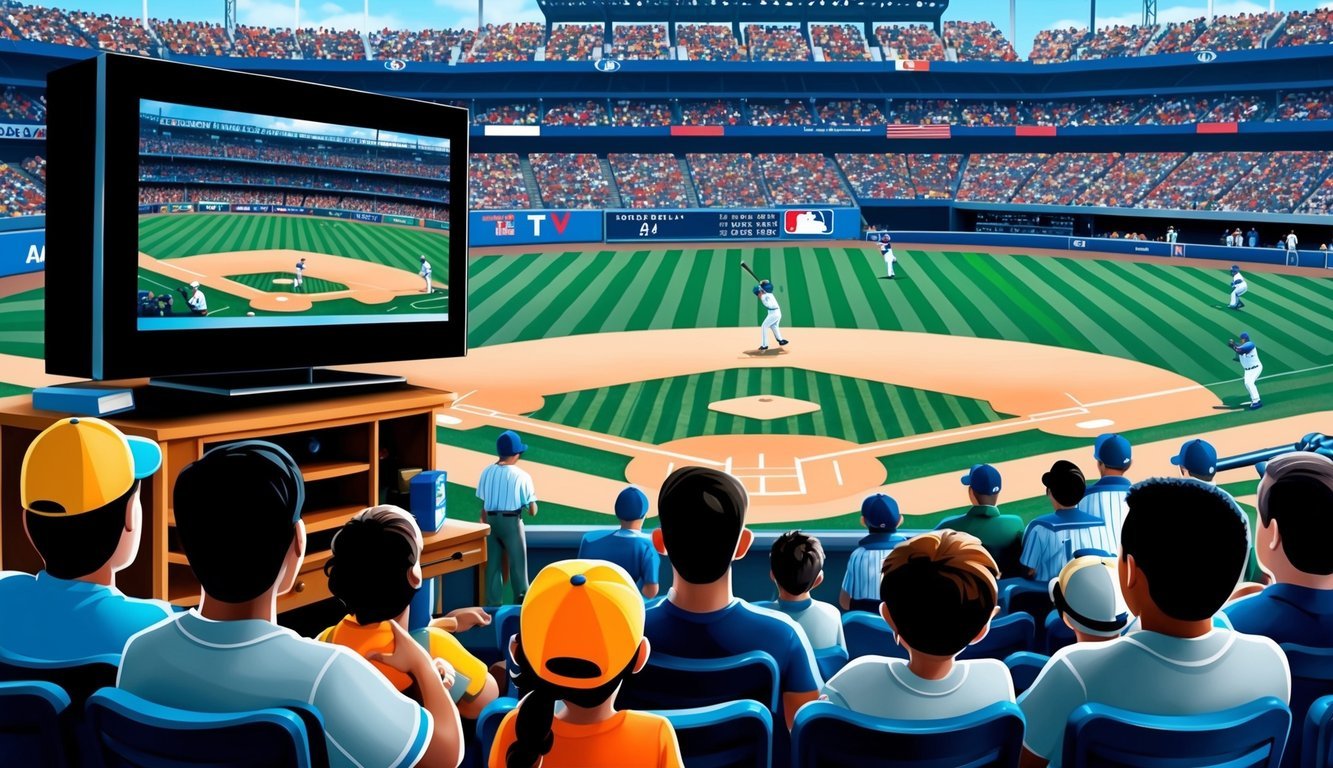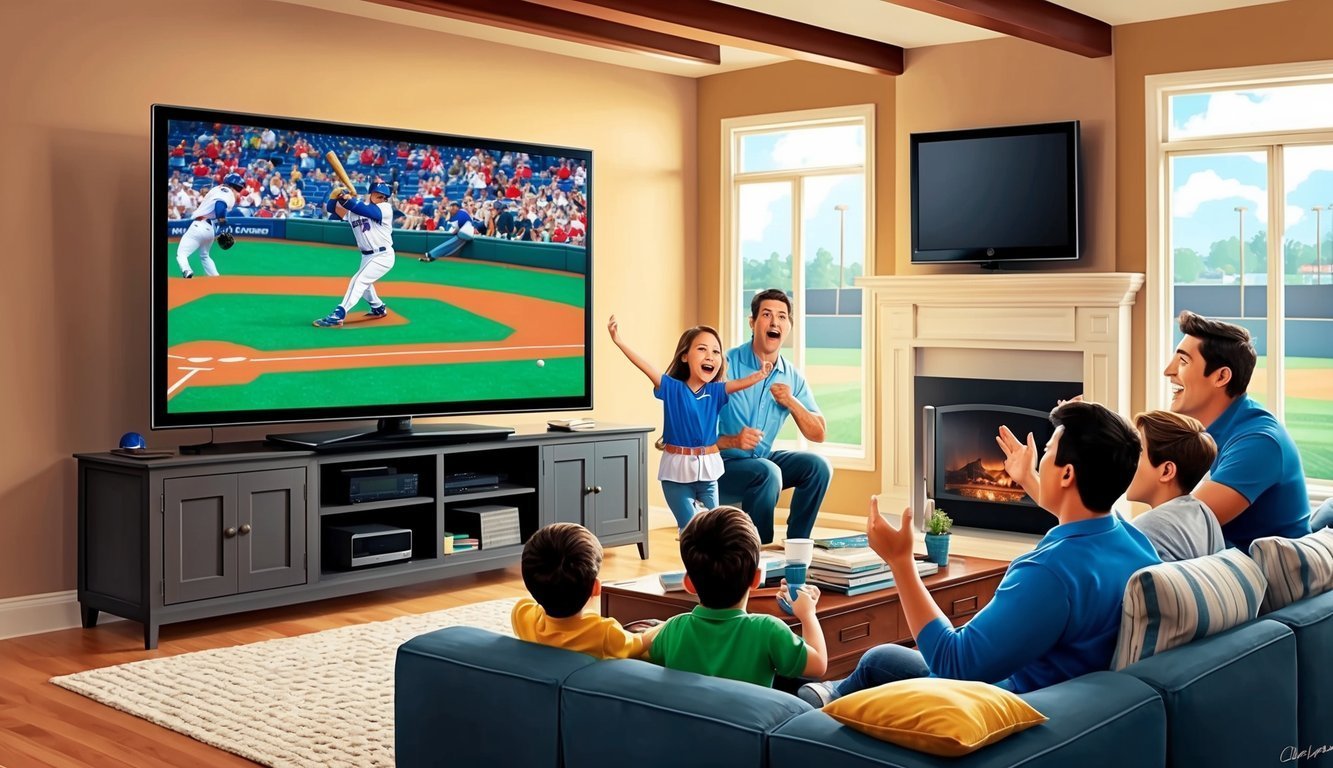Television broadcasts revolutionized baseball, bringing America’s pastime into living rooms across the nation.
In 1955, NBC aired the first World Series in color, transforming how fans experienced the game.
The vibrant green of the outfield and crisp white uniforms popped off the screen, making viewers feel closer to the action than ever before.
TV broadcasts have significantly influenced baseball’s rules, scheduling, and uniform designs to enhance the viewing experience. Teams began incorporating brighter colors and more distinctive logos to stand out on screen.
The introduction of instant replay in 1959 allowed fans to relive key moments and fueled debates about controversial calls.
As technology advanced, so did baseball coverage.
High-definition cameras and super slow-motion replays offer unprecedented views of pitches and plays.
Online streaming now lets fans watch games on various devices, freeing them from traditional TV sets and expanding baseball’s reach to new audiences.
Historical Evolution of Baseball Broadcasting
Baseball broadcasting transformed how fans experienced the game, bringing it from stadiums into homes across America.
The journey from radio to television revolutionized sports media and created legendary voices that became synonymous with the sport.
From Radio to Television
Radio broadcasts of baseball games began in the 1920s, captivating listeners with play-by-play action.
KDKA in Pittsburgh aired the first baseball game in 1921, ushering in a new era for the sport.
The Philadelphia Phillies were early adopters of radio, broadcasting games regularly by 1927.
Baseball Commissioner Kenesaw Mountain Landis initially resisted radio, fearing it would hurt attendance.
Television entered the scene in the late 1930s.
NBC aired the first televised baseball game in 1939 between Columbia and Princeton.
Major League games followed soon after, with the Brooklyn Dodgers leading the charge in 1946.
By the 1950s, TV broadcasts became widespread, offering fans a visual feast of their favorite players and teams.
This shift dramatically increased baseball’s popularity and reach.
Pioneering Broadcasters and Milestones
Red Barber and Mel Allen emerged as iconic voices of baseball, shaping the art of sports commentary.
Barber’s colorful phrases and Allen’s signature “How about that!” became part of baseball lore.
Radio announcers had to paint vivid pictures with words, developing unique styles to keep listeners engaged.
They became storytellers, weaving game action with player anecdotes and statistics.
Television brought new challenges and opportunities.
Broadcasters adapted their styles to complement the visual medium.
They learned to let the pictures speak while providing insightful commentary.
RCA played a crucial role in advancing broadcast technology.
Their innovations in both radio and television equipment helped deliver clearer, more reliable game coverage to eager fans.
Impact on Fan Experience and Fandom

Television broadcasts have revolutionized how baseball fans engage with the sport.
They’ve brought the game into living rooms and created new ways for fans to connect with their favorite teams and players.
Accessibility and Convenience
TV broadcasts have made baseball more accessible than ever.
Fans can watch games from the comfort of their homes, eliminating the need to travel to stadiums.
This convenience has expanded the sport’s reach, allowing people in different cities or countries to follow their favorite teams.
Portable radios have given way to smartphones and tablets.
Now, fans can stream games on MLB.tv or other services while on the go.
This flexibility means never missing a pitch, whether at work or on vacation.
Advancements in Viewing Technology
High-definition cameras and multiple camera angles have transformed the viewing experience.
Fans can now see every detail of the action, from a pitcher’s grip to a batter’s stance.
Slow-motion replays and on-screen graphics enhance understanding of the game.
They highlight key moments and provide stats that weren’t available to previous generations of fans.
Virtual reality is creating more immersive experiences.
Some broadcasts offer 360-degree views, letting fans feel like they’re right on the field.
Interactive features are becoming common.
Fans can now participate in polls, access player stats, and even choose their preferred commentary team during broadcasts.
Economic Influences on the Baseball Industry

Television broadcasts have dramatically shaped baseball’s financial landscape.
The sport has seen massive revenue growth and new marketing opportunities emerge through its relationship with TV networks.
Revenue Generation from Broadcasts
Major League Baseball has experienced exponential growth in broadcast-related income.
TV deals now represent a significant portion of the league’s revenue.
In recent decades, MLB’s television revenue has skyrocketed by 2800%.
This influx of money has transformed team finances.
Clubs can now offer players larger contracts, with some stars signing deals worth hundreds of millions of dollars.
The Philadelphia Phillies, for example, signed Bryce Harper to a 13-year, $330 million contract.
Local TV deals have become especially lucrative for teams.
These agreements provide steady income streams and help smaller market clubs compete financially with larger ones.
Advertising and Marketing Strategies
TV broadcasts have opened new avenues for baseball advertising.
Companies eagerly sponsor game segments, statistics graphics, and in-stadium signage to reach large audiences.
Teams and MLB have developed sophisticated marketing campaigns around televised games.
They use social media tie-ins and second-screen experiences to boost fan engagement during broadcasts.
Player endorsements have gained value as TV exposure increases.
Star athletes can now earn substantial sums promoting products both during games and in commercials.
MLB has also leveraged broadcasts to market its own products.
The league promotes ticket sales, merchandise, and special events through targeted ads during games.
Role in Promoting Baseball as America’s Pastime

Television broadcasts played a crucial role in cementing baseball’s status as America’s pastime.
They brought the game into homes across the nation, creating new fans and deepening existing connections.
As technology advanced, high-definition broadcasts and instant replays enhanced the viewing experience, making the game more accessible and engaging.
In recent years, changes such as the baseball pitch clock rules have aimed to speed up the game, appealing to modern audiences with shorter attention spans.
These adjustments, combined with widespread television coverage, ensure that baseball remains a dynamic and evolving sport for future generations.
Tradition versus Innovation
TV broadcasts struck a delicate balance between honoring baseball’s traditions and embracing innovation.
Classic stadiums like Wrigley Field and Fenway Park became familiar sights to viewers nationwide.
Commentary often highlighted the sport’s rich history and time-honored rituals.
At the same time, broadcasters introduced new camera angles and instant replays.
These innovations enhanced the viewing experience, allowing fans to see the game in unprecedented detail.
Slow-motion replays of spectacular catches and powerful home runs became iconic moments.
TV coverage also spotlighted baseball’s deep roots in American culture, especially in Midwest communities.
Small-town ballparks and local heroes gained national exposure, reinforcing the sport’s connection to heartland values.
Embracing the Internet Age
As the internet grew, baseball broadcasts evolved to stay relevant.
ESPN and other networks launched online platforms, offering live streaming and on-demand highlights.
These digital options made games more accessible to younger fans.
Social media integration became a key feature of baseball broadcasts.
Fans could interact with commentators and each other in real-time, sharing their thoughts on plays and decisions.
This engagement helped create a sense of community among viewers.
Fantasy baseball leagues gained popularity, fueled by the wealth of statistics and analysis provided during broadcasts.
This blend of tradition and technology helped baseball maintain its appeal in a rapidly changing media landscape.
The Future of Baseball Broadcasts
Baseball broadcasts are poised for significant changes as technology and viewer preferences evolve.
New innovations aim to enhance fan engagement and provide deeper insights into the game.
Adopting New Technology and Data Analytics
Augmented reality (AR) could transform how fans watch baseball.
Imagine seeing player stats hovering above athletes on the field or pitch trajectories overlaid on the screen.
Statcast data might be integrated more seamlessly, allowing viewers to access advanced metrics with a click.
Streaming services are likely to play a bigger role.
Personalized feeds could let fans choose camera angles or commentary styles.
Interactive features might include live polls or fantasy baseball integration.
Data analytics will probably become more prominent in broadcasts.
Announcers may use predictive models to discuss strategic decisions in real-time.
Graphics could visualize complex stats in easy-to-understand ways.
Challenges and Opportunities
Balancing innovation with tradition poses a challenge for baseball broadcasts.
Some fans may resist changes to the viewing experience they’ve grown accustomed to over decades.
Accessibility is another hurdle.
New tech-heavy broadcasts might alienate older viewers or those without high-speed internet.
Broadcasters will need to ensure their content remains inclusive.
There’s an opportunity to attract younger audiences with engaging, interactive content.
Social media integration could allow fans to participate in discussions or share highlights instantly.
Monetization strategies will likely evolve.
Pay-per-view special broadcasts or subscription-based premium features might become more common as cable TV’s influence wanes.
